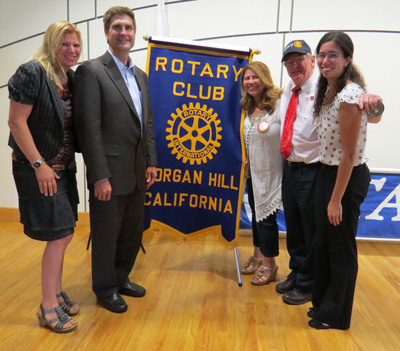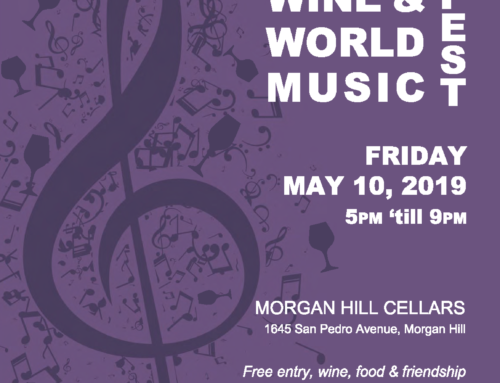SVLG president Carl Guardino says MH has some innovative firms
Published in the July 23 – August 5, 2014 issue of Morgan Hill Life
By Staff Report

Photo by Marty Cheek
From left, Rotary Club member Lori McIntosh, SVLG President Carl Guardino, Rotary Club member Liza Garibaldi, Rotary President Peter Anderson and SVLG intern Megan White at the June 25 meeting.
Rotary Club of Morgan Hill members learned about the state of Silicon Valley’s economy and how the South Valley region fits in when Carl Guardino, the president of the Silicon Valley Leadership Group, visited the club June 25.
Guardino was introduced by Rotarian and Morgan Hill Mayor Steve Tate at the noon lunch meeting.
“When you think about business in Silicon Valley, you think about innovation and entrepreneurship,” Tate said. “And when you think about the Silicon Valley Leadership Group, you almost always automatically think about Carl Guardino. He’s the face of that organization he has led since 1997.”
Guardino gave the members a brief history of SVLG, saying it was founded by David Packard, co-founder of Hewlett Packard, as a way to bring business people together to address quality of life issues in Santa Clara County. Although the geographic outline of Silicon Valley is open to debate, the SVLG considers it as encompassing San Francisco, Santa Clara, and San Mateo counties and portions of Alameda and Santa Cruz counties. About 2.4 million people live in this area, with 1 million jobs and more than 7,000 high-tech companies.
Overall, the Silicon Valley economy is re-surging — and is ahead of the rest of the state of California and the United States, Guardino said.
“Our unemployment rate is starting to shrink and we’re leading the nation once again in recovery,” he said. “Silicon Valley as we define it has a 5.5 percent unemployment rate while the nation is 6.3 percent. California is still behind a bit at 7.6 percent.”
One of Silicon Valley’s greatest economic strengths is its waves of innovation, much of which comes for the highly educated work force living here, he said.
The Economist magazine ranks the best universities around the world, and three of the top are in the Bay Area region — Stanford University, the University of California at Berkeley, and University California at San Francisco.
Another component of the work force is the foreign-born engineers and business leaders who have come to the Bay Area, Guardino said.
“That global strength of having talent from around the world is something we never take for granted,” he said. “Fifty-three percent of engineers that fuel our companies right here in Silicon Valley weren’t born in the United States. More than 50 percent of the companies created for the last 10 years in the Silicon Valley either have a co-founder or a CEO who wasn’t blessed to be born in the United States.”
More than 50 percent of college professors instructing in technical degrees and more than 50 percent of students earning those degrees weren’t born in the United States, he added.
The club members discussed with Guardino South Valley’s relationship to Silicon Valley and how Morgan Hill might be perceived by professionals.
“I think Morgan Hill is a well-kept secret,” said Carl Berghoff, a Rotarian and chief executive officer at Opto Electronix based in San Jose. “I don’t know why from an industry stand-point more (companies) don’t migrate down here. We’re only 30 minutes away from a large airport. The cost of doing business down here is much less than 20 minutes up the road. I can’t explain. It’s a well kept secret. We’re enjoying certain aspects of the secret.”
Guardino noted that Morgan Hill has several companies that are noted for the high quality of their products including Specialized Bicycle Components and electronics testing equipment firm Anritsu.
“You have great companies here that are very innovative, and they don’t have to be tech,” he said.






